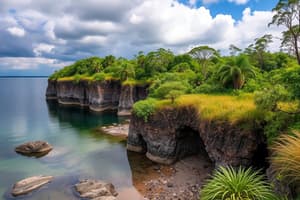Podcast
Questions and Answers
What is meant by the term 'biological diversity'?
What is meant by the term 'biological diversity'?
- The variety of life-forms in an area (correct)
- The genetic disadvantages of species
- The total biomass of an area
- The populations of a single species
Which reason for valuing biodiversity focuses on its direct benefits to humans?
Which reason for valuing biodiversity focuses on its direct benefits to humans?
- Moral
- Aesthetic
- Utilitarian (correct)
- Ecological
What does the public service reason for valuing biodiversity highlight?
What does the public service reason for valuing biodiversity highlight?
- Aesthetic beauty in nature
- The right of species to exist irrespective of utility
- Species' roles in their ecosystems
- Nature's essential services to humans (correct)
Which of the following reasons for valuing biodiversity argues for the inherent rights of species?
Which of the following reasons for valuing biodiversity argues for the inherent rights of species?
The ecological reason for valuing biodiversity emphasizes the importance of which concept?
The ecological reason for valuing biodiversity emphasizes the importance of which concept?
Which reason for valuing biodiversity is not typically associated with direct human benefits?
Which reason for valuing biodiversity is not typically associated with direct human benefits?
The aesthetic reason for valuing biodiversity is primarily concerned with which aspect?
The aesthetic reason for valuing biodiversity is primarily concerned with which aspect?
Which of the following is NOT a primary reason for valuing biodiversity?
Which of the following is NOT a primary reason for valuing biodiversity?
What term describes the loss of a single population of a species?
What term describes the loss of a single population of a species?
Which aspect of species diversity refers to the total number of different species present?
Which aspect of species diversity refers to the total number of different species present?
What is a characteristic of an endemic species?
What is a characteristic of an endemic species?
What is meant by species evenness in the context of biodiversity?
What is meant by species evenness in the context of biodiversity?
What describes habitat diversity?
What describes habitat diversity?
Which reason explains why people value biodiversity in a spiritual way?
Which reason explains why people value biodiversity in a spiritual way?
Which factor contributes to the decline of certain species due to diseases like chytrid fungi?
Which factor contributes to the decline of certain species due to diseases like chytrid fungi?
What aspect of biodiversity is focused on the beauty and variety of life in nature?
What aspect of biodiversity is focused on the beauty and variety of life in nature?
What percentage of the global population lacks access to basic sanitation?
What percentage of the global population lacks access to basic sanitation?
Which of the following diseases is NOT commonly linked to environmental factors?
Which of the following diseases is NOT commonly linked to environmental factors?
Which activity is NOT associated with adverse environmental effects?
Which activity is NOT associated with adverse environmental effects?
What significant environmental consequence is associated with food production?
What significant environmental consequence is associated with food production?
Why is safeguarding coral reefs crucial?
Why is safeguarding coral reefs crucial?
What is described as the death of a species, resulting in the elimination of all individuals of that species?
What is described as the death of a species, resulting in the elimination of all individuals of that species?
What is the rate of disappearance of species during a mass extinction event compared to usual rates?
What is the rate of disappearance of species during a mass extinction event compared to usual rates?
What environmental change was primarily responsible for the eradication of malaria in the 1940s and 50s?
What environmental change was primarily responsible for the eradication of malaria in the 1940s and 50s?
How does the loss of biodiversity primarily affect ecosystems?
How does the loss of biodiversity primarily affect ecosystems?
Which factor is a serious impact of climate change on biodiversity?
Which factor is a serious impact of climate change on biodiversity?
What role do conservation biologists play in biodiversity protection?
What role do conservation biologists play in biodiversity protection?
Why is biodiversity considered important for sustainability in ecosystems?
Why is biodiversity considered important for sustainability in ecosystems?
What often contributes to a non-native species becoming invasive in a new environment?
What often contributes to a non-native species becoming invasive in a new environment?
According to the concept of ecosystems, what factors are interconnected in understanding biodiversity?
According to the concept of ecosystems, what factors are interconnected in understanding biodiversity?
What is a potential consequence of having a high number of golden snails in a rice field?
What is a potential consequence of having a high number of golden snails in a rice field?
What is a common consequence of over-exploitation of natural resources?
What is a common consequence of over-exploitation of natural resources?
Which statement reflects the view of Marco Lambertini regarding wildlife disappearance?
Which statement reflects the view of Marco Lambertini regarding wildlife disappearance?
How does pollution typically affect biological systems?
How does pollution typically affect biological systems?
What ultimately depends on the services and products provided by ecosystems?
What ultimately depends on the services and products provided by ecosystems?
Which characteristic is essential for the best functioning of intact ecosystems?
Which characteristic is essential for the best functioning of intact ecosystems?
What does the concept of ecosystem resilience refer to?
What does the concept of ecosystem resilience refer to?
What type of ecosystem is considered to be 'dead'?
What type of ecosystem is considered to be 'dead'?
What challenge do species face due to global climate change?
What challenge do species face due to global climate change?
Which of the following is NOT a method through which organisms in intact ecosystems operate?
Which of the following is NOT a method through which organisms in intact ecosystems operate?
Flashcards are hidden until you start studying
Study Notes
Biological Diversity
- Refers to the variety of life forms, measured by the number of species or genetic types in an area.
- Population: Group of individuals of the same species in a specific area.
- Species: Individuals capable of interbreeding, encompassing all populations within that species.
Value of Biodiversity
- Utilitarian: Species provide products beneficial to humans, such as food, lumber, and medicines.
- Public Service: Nature contributes essential services like carbon dioxide absorption and pollination, which are costly or impossible to replicate.
- Ecological: Species play vital roles in ecosystems; their persistence is crucial for ecosystem survival.
- Moral: Belief that species have a right to exist, regardless of their utility to humans.
- Theological: Some religions emphasize valuing nature and biodiversity, reflecting spiritual beliefs.
- Aesthetic: The beauty of nature, including diverse life forms, enhances human experience.
- Recreational: Interaction with nature offers healthful activities and enjoyment.
- Spiritual: Experiences in nature can feel uplifting and have religious significance.
- Creative: Nature inspires artists, writers, and musicians, stimulating creativity.
Types of Biodiversity
- Genetic Diversity: Total number of genetic characteristics within a species or group.
- Habitat Diversity: Variation of habitats within a specific area.
- Species Diversity: Includes species richness (total number of species), species evenness (relative abundance), and species dominance (most abundant species).
Biodiversity Loss
- Extirpation: Loss of a population of a species from a specific area.
- Extinction: Permanent disappearance of all populations of a species.
- Endemic Species: Species native to a particular region.
- Major causes include habitat loss, over-exploitation, pollution, climate change, and invasive species.
Threat of Mass Extinction
- Currently at risk of a sixth mass extinction, with species disappearing at unprecedented rates.
- Human activities, such as industrialization and habitat destruction, contribute significantly to biodiversity loss.
- Mass extinction events are characterized by species disappearing at rates 1,000 times greater than natural background rates.
Ecosystem Dynamics
- Biodiversity is essential for ecosystem stability and resilience against disturbances.
- Intact ecosystems operate more efficiently, supporting a variety of interactions and processes critical to survival.
- The presence of diverse species can enhance the ability of ecosystems to withstand environmental changes.
Human Health and Environment
- Biodiversity directly impacts human health, with many illnesses connected to environmental factors.
- Activities to promote health can inadvertently stress ecosystems, leading to negative environmental consequences.
Climate Change Impact
- Global climate change significantly threatens biodiversity, with species unable to adapt rapidly facing extinction.
- Coral reefs, crucial for coastal protection and biodiversity, are declining, emphasizing the need for their conservation.
Conservation Efforts
- Establishing protected areas such as parks and nature reserves helps mitigate biodiversity loss.
- Conservation biology applies principles of ecology to safeguard populations, communities, and ecosystems effectively.
Studying That Suits You
Use AI to generate personalized quizzes and flashcards to suit your learning preferences.




